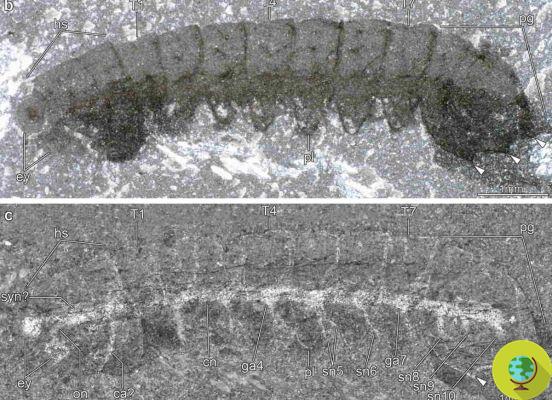
According to archaeologists, these fossil insects, dating back more than 500 million years, have something in common with modern arachnids.
According to archaeologists, these fossil insects, dating back more than 500 million years, have something in common with modern arachnids.
They are smaller than a dime, yet their importance to the scientific community is enormous: they are two tiny fossils, dating back to 508 million years ago, and what makes them so special is the fact that within them they have preserved traces of perfectly preserved nervous tissue.
These are certainly two specimens similar to the species Mollisonia symmetrica (from the family of arthropods, a group that also includes modern insects, crustaceans and arachnids) - to be considered as the ancestor of modern insects. Unfortunately, the conditions of conservation of fossils do not allow scientists to understand exactly the characteristics of the species, but a close relationship with modern spiders is not excluded.
The periodization of the fossils found is to be restricted to the Cambrian period (540-490 million years ago): finding traces of nerve tissue that can be dated back in time is a real rarity. The first discovery in this field dates back to 2012, when archaeologists discovered the first evidence of fossilized arthropod brains. Over the past decade, there have been at least a dozen fossils dating back to the Cambrian period and containing remains of nerve tissue - almost all of them arthropods.
The newly discovered fossils measure one 13 millimeters in length and 3,5 millimeters in width at its widest point, the other only 7,5 millimeters in length and 1,7 in height. The two finds differ not only in size but also in the position in which they were found: one is in a normal position, oriented towards the other, which is instead lying on its side. Both have a very simple structure, with an exoskeleton consisting of a head, a segmented trunk and a rear shield (not very different, in composition, from that of a bedbug). Both fossils have no appendages or legs, but scientists suspect these prehistoric animals were endowed with six pairs of small limbs and tiny fangs.
The traces of nerve tissue preserved within the fossils appear as dark spots: this is because the fossilization process has transformed the tissue into organic carbon film. In both fossils, the researchers were able to identify optic nerves that start from the animals' eyes and then head towards the main body; in addition, a kind of nerve tissue has been observed inside the head, which is hypothesized to be possible represent something like a brain.
Follow your Telegram | Instagram | Facebook | TikTok | Youtube
Source: Nature
We also recommend:
- The largest ichthyosaur fossil ever found so far has been unearthed
- The giant insects that prey on turtles, ducklings and even snakes
- Violin spider: how it is made and how to recognize its bite


























